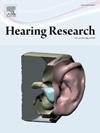Early signs of auditory aging: Hearing declines faster in individuals with extended high frequency hearing loss
IF 2.5
2区 医学
Q1 AUDIOLOGY & SPEECH-LANGUAGE PATHOLOGY
引用次数: 0
Abstract
Hearing loss, particularly age-related hearing loss, significantly impacts health and quality of life worldwide. While much of the research has focused on older adults, the early stages of hearing decline remain relatively unexplored. Longitudinal studies examining hearing changes across the adult lifespan, especially at extended high frequencies (EHFs), are scarce. This prospective longitudinal study aimed to explore the rate of hearing threshold shift in young adults with clinically normal audiograms and to assess whether EHF hearing loss could predict future hearing decline in the standard audiometric range. Hearing thresholds were measured at standard audiometric frequencies (0.25 to 8 kHz) and EHFs (10, 12.5, 14, and 16 kHz) in 71 participants (24 females) aged 19 to 38 years (mean age = 27.8 years). Two testing sessions were conducted nearly 24 months apart. Results revealed that the annual rate of threshold shift was significantly higher for EHFs compared to standard audiometric frequencies. A higher EHF threshold, measured in the initial test session, was associated with a greater rate of threshold shift at standard audiometric frequencies, suggesting that EHF hearing loss may serve as an early marker for subsequent hearing decline. Even with a normal audiogram, individuals with EHF hearing loss are at an increased risk of accelerated hearing deterioration. These findings show preclinical, age-related changes in young adults with normal audiograms and underscore the importance of early detection and monitoring of EHF hearing loss to mitigate the impact of future hearing loss on their overall health and well-being.
听觉老化的早期迹象:听力下降速度更快的个人与延长高频听力损失。
听力损失,特别是与年龄有关的听力损失,严重影响全世界的健康和生活质量。虽然大部分研究都集中在老年人身上,但听力下降的早期阶段仍然相对未被探索。在成年人的整个生命周期中,特别是在延长的高频(EHFs)中,关于听力变化的纵向研究很少。这项前瞻性纵向研究旨在探讨临床听力图正常的年轻成年人的听阈漂移率,并评估EHF听力损失是否可以预测未来标准听力范围内的听力下降。在标准听力频率(0.25至8 kHz)和ehf(10、12.5、14和16 kHz)下测量71名年龄在19至38岁(平均年龄= 27.8岁)的参与者(24名女性)的听力阈值。两次测试相隔近24个月。结果显示,与标准听力学频率相比,ehf的年阈值移位率明显更高。在初始测试阶段测得的EHF阈值越高,在标准听力学频率下的阈值移位率越高,这表明EHF听力损失可能是随后听力下降的早期标志。即使听力图正常,EHF听力损失患者加速听力恶化的风险也会增加。这些发现显示了听力正常的年轻成年人的临床前、年龄相关变化,并强调了早期发现和监测EHF听力损失的重要性,以减轻未来听力损失对他们整体健康和福祉的影响。
本文章由计算机程序翻译,如有差异,请以英文原文为准。
求助全文
约1分钟内获得全文
求助全文
来源期刊

Hearing Research
医学-耳鼻喉科学
CiteScore
5.30
自引率
14.30%
发文量
163
审稿时长
75 days
期刊介绍:
The aim of the journal is to provide a forum for papers concerned with basic peripheral and central auditory mechanisms. Emphasis is on experimental and clinical studies, but theoretical and methodological papers will also be considered. The journal publishes original research papers, review and mini- review articles, rapid communications, method/protocol and perspective articles.
Papers submitted should deal with auditory anatomy, physiology, psychophysics, imaging, modeling and behavioural studies in animals and humans, as well as hearing aids and cochlear implants. Papers dealing with the vestibular system are also considered for publication. Papers on comparative aspects of hearing and on effects of drugs and environmental contaminants on hearing function will also be considered. Clinical papers will be accepted when they contribute to the understanding of normal and pathological hearing functions.
 求助内容:
求助内容: 应助结果提醒方式:
应助结果提醒方式:


